Murine neural stem/progenitor cells protect neurons against ischemia by HIF-1alpha-regulated VEGF signaling
- PMID: 20339541
- PMCID: PMC2842303
- DOI: 10.1371/journal.pone.0009767
Murine neural stem/progenitor cells protect neurons against ischemia by HIF-1alpha-regulated VEGF signaling
Abstract
Focal cerebral ischemia following middle cerebral artery occlusion (MCAO) stimulates a robust cytogenic response from the adult subventricular zone (SVZ) that includes massive proliferation of neural stem/progenitor cells (NSPCs) and cellular migration into the injury area. To begin to explore beneficial roles of NSPCs in this response, we investigated the ability of embryonic and postnatal NSPCs to promote neuronal survival under conditions of in vivo and in vitro ischemia. Intracerebral transplantation of NSPCs attenuated neuronal apoptosis in response to focal ischemia induced by transient MCAO, and prevented neuronal cell death of cortical neurons in response to oxygen-glucose deprivation (OGD) in culture. NSPC-mediated neuroprotection was blocked by the pharmacological inhibitors of vascular endothelial growth factor (VEGF), SU1498 and Flt-1Fc. Embryonic and postnatal NSPCs were both intrinsically resistant to brief OGD exposure, and constitutively expressed both hypoxia-inducible factor 1alpha (HIF-1alpha) transcription factor and its downstream target, VEGF. Genomic deletion of HIF-1alpha by Cre-mediated excision of exon 2 in NSPC cultures resulted in >50% reduction of VEGF production and ablation of NSPC-mediated neuroprotection. These findings indicate that NSPCs promote neuronal survival under ischemic conditions via HIF-1alpha-VEGF signaling pathways and support a role for NSPCs in promotion of neuronal survival following stroke.
Conflict of interest statement
Figures
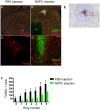
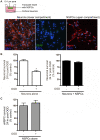
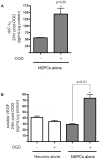
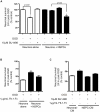
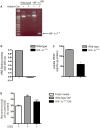

Similar articles
-
Roles for HIF-1α in neural stem cell function and the regenerative response to stroke.Behav Brain Res. 2012 Feb 14;227(2):410-7. doi: 10.1016/j.bbr.2011.08.002. Epub 2011 Aug 18. Behav Brain Res. 2012. PMID: 21871501 Free PMC article. Review.
-
Neural stem/progenitor cells promote endothelial cell morphogenesis and protect endothelial cells against ischemia via HIF-1alpha-regulated VEGF signaling.J Cereb Blood Flow Metab. 2008 Sep;28(9):1530-42. doi: 10.1038/jcbfm.2008.38. Epub 2008 May 14. J Cereb Blood Flow Metab. 2008. PMID: 18478024 Free PMC article.
-
Preconditioning with the traditional Chinese medicine Huang-Lian-Jie-Du-Tang initiates HIF-1α-dependent neuroprotection against cerebral ischemia in rats.J Ethnopharmacol. 2014 Jun 11;154(2):443-52. doi: 10.1016/j.jep.2014.04.022. Epub 2014 Apr 19. J Ethnopharmacol. 2014. PMID: 24751364
-
Roles of HIF-1α, VEGF, and NF-κB in Ischemic Preconditioning-Mediated Neuroprotection of Hippocampal CA1 Pyramidal Neurons Against a Subsequent Transient Cerebral Ischemia.Mol Neurobiol. 2017 Nov;54(9):6984-6998. doi: 10.1007/s12035-016-0219-2. Epub 2016 Oct 26. Mol Neurobiol. 2017. PMID: 27785755
-
P75 neurotrophin receptor controls subventricular zone neural stem cell migration after stroke.Cell Tissue Res. 2022 Mar;387(3):415-431. doi: 10.1007/s00441-021-03539-z. Epub 2021 Oct 26. Cell Tissue Res. 2022. PMID: 34698916 Free PMC article. Review.
Cited by
-
Possible Role of PHD Inhibitors as Hypoxia-Mimicking Agents in the Maintenance of Neural Stem Cells' Self-Renewal Properties.Front Cell Dev Biol. 2018 Dec 11;6:169. doi: 10.3389/fcell.2018.00169. eCollection 2018. Front Cell Dev Biol. 2018. PMID: 30619851 Free PMC article.
-
Induced pluripotent stem cell-derived neural stem cells: new hope for stroke?Stem Cell Res Ther. 2013;4(5):115. doi: 10.1186/scrt326. Stem Cell Res Ther. 2013. PMID: 24067059 Free PMC article.
-
Moderate fetal alcohol exposure impairs neurogenic capacity of murine neural stem cells isolated from the adult subventricular zone.Exp Neurol. 2011 Jun;229(2):522-5. doi: 10.1016/j.expneurol.2011.03.007. Epub 2011 Mar 16. Exp Neurol. 2011. PMID: 21419122 Free PMC article.
-
Roles for HIF-1α in neural stem cell function and the regenerative response to stroke.Behav Brain Res. 2012 Feb 14;227(2):410-7. doi: 10.1016/j.bbr.2011.08.002. Epub 2011 Aug 18. Behav Brain Res. 2012. PMID: 21871501 Free PMC article. Review.
-
Matrix metalloproteinase (MMP)-9 induced by Wnt signaling increases the proliferation and migration of embryonic neural stem cells at low O2 levels.J Biol Chem. 2011 May 20;286(20):17649-57. doi: 10.1074/jbc.M111.229427. Epub 2011 Apr 1. J Biol Chem. 2011. PMID: 21460212 Free PMC article.
References
-
- Eriksson PS, Perfilieva E, Bjork-Eriksson T, Alborn AM, Nordborg C, et al. Neurogenesis in the adult human hippocampus. Nat Med. 1998;4:1313–1317. - PubMed
-
- Gage FH. Mammalian neural stem cells. Science. 2000;287:1433–1438. - PubMed
-
- Doetsch F. A niche for adult neural stem cells. Curr Opin Genet Dev. 2003;13:543–550. - PubMed
-
- Alvarez-Buylla A, Lim DA. For the long run: maintaining germinal niches in the adult brain. Neuron. 2004;41:683–686. - PubMed
-
- McKay R. Stem cells in the central nervous system. Science. 1997;276:66–71. - PubMed
Publication types
MeSH terms
Substances
LinkOut - more resources
Full Text Sources
Medical
Molecular Biology Databases

